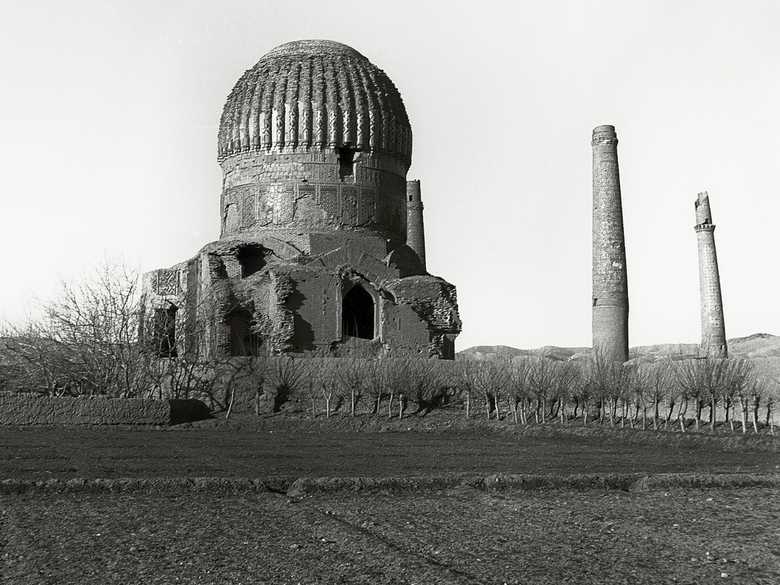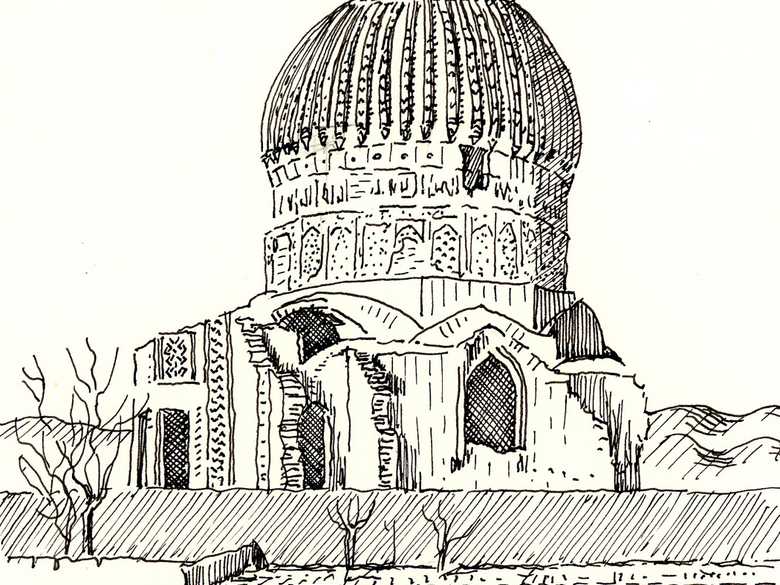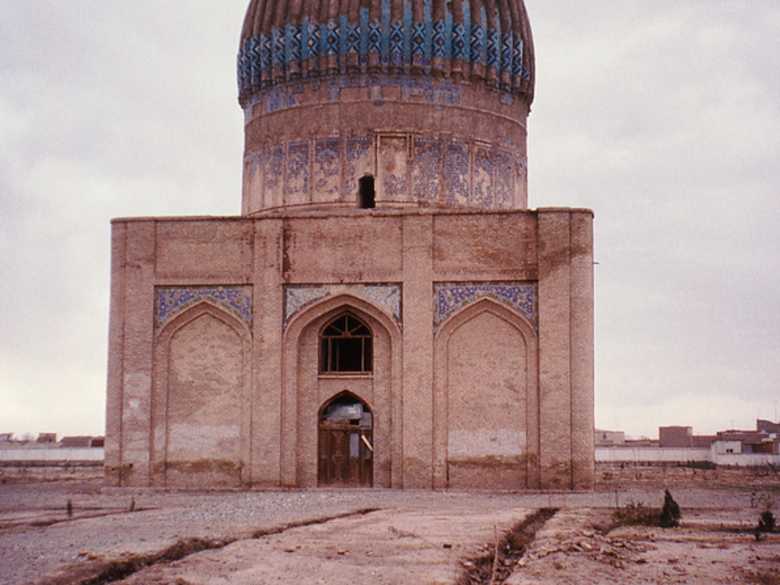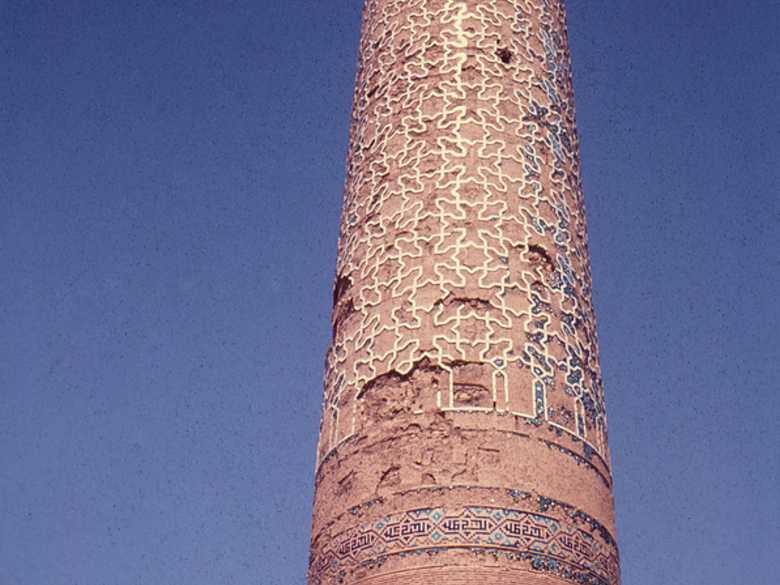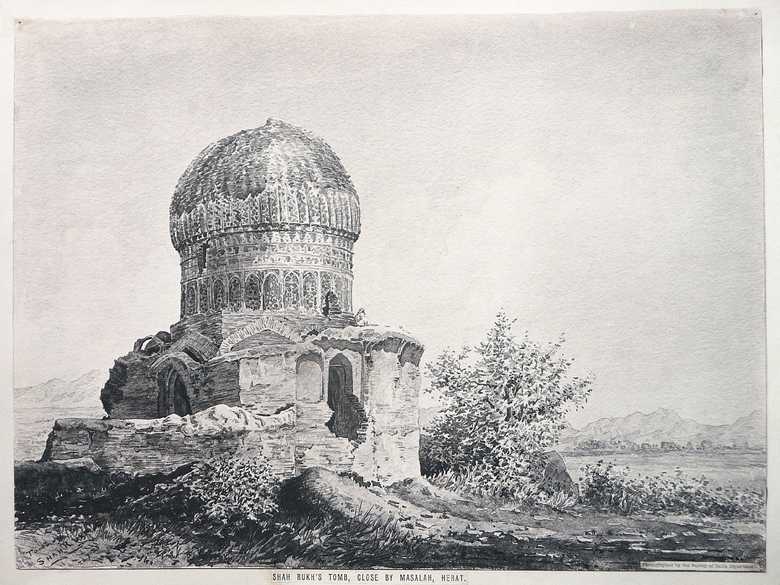RS 376 — Ansicht des Musalla-Komplexes von Süden
|RS 376-1| Ansicht des Musalla-Komplexes von Süden. Im Vordergrund die Rippenkuppel des Grabmals von Gauhar-Shad, dahinter drei der vier Minarette der Madrasah von Sultan Husayn Bayqara.
|RS 376-4| Aufnahme von Ch. Jentsch, 1963: Eines der vier Minarette der Madrasah von Sultan Husayn Bayqara.
|RS 376-5| Collection Edward L. Durand: Zeichnung ELD 024: „Shah Rukh’s tomb, close by Masalah, Herat.“
|RS 376-1|
Ansicht des Musalla-Komplexes von Süden. Im Vordergrund die Rippenkuppel des Grabmals von Gauhar-Shad, dahinter drei der vier Minarette der Madrasah von Sultan Husayn Bayqara.
[Roter Hefter:] Grabkuppel bei Herat. Nr. 9.
- R. Stuckert (1994): Erinnerungen an Afghanistan, S. 64: Federzeichnung: „Abb. 69: Herat, Kuppel über dem Mausoleum der Gauhar-Shad.“
S. 65: „[…] Gut erhalten ist die Kuppel über dem Mausoleum der Gauhar-Shad, der Gattin von Shah-Rukh, einem Sohn Timurs. Mit ihrer gerippten Kuppel aus türkisfarbenen Fliesen ist sie ein Schmuckstück.“
S. 65: „Die Türkisfarbe wird hier besonders stark empfunden. Der Haupteindruck der Landschaft und der aus dem gleichen Erdmaterial erstellten profanen Bauten ist ein rötlich-gelbes, warmes Grau der Felsen und Steppen. Türkis ist dazu die Komplementärfarbe. Diese Farbe wirkt, ‚wie wenn die Materie zum Himmel werden möchte‘. Deshalb sind fast alle Kuppeln türkisfarben, schwerelos als Farbe, durch Plastik, Rippen, Kanten, etc. doch wieder räumlich zusammengefasst.“ - Collection Edward L. Durand: Zeichnung ELD 024 zeigt das Grabmal von Gauhar-Shad.
- D. Brandenburg (1977): Herat, eine timuridische Hauptstadt, S. 38: „[…] Das genaue Datum der Errichtung des Mausoleums ist nicht bekannt (vermutlich bereits 1432/1433; […]). Da das Mausoleum vermutlich von der oder für die Königin gebaut wurde, trägt es heute noch deren Namen. In Wirklichkeit handelt es sich um das Grabmal der Timuridenfamilie in Herat und bildet eine Parallele zum Grab der Timuridenfamilie in Samarqand[.] […]“
S. 39: „[…] Auf einem im Kern aus acht Bogen bestehenden, aussen quadratisch ummauerten Unterbau sitzt der hohe Tambour mit einem Emporengeschoss und rundet sich zur äusseren Kuppelschale, die eine tiefer sitzende innere überdeckt. […]“
S. 39: „Die eigentliche Kuppel ist an der Oberfläche kräftig kanneliert und gehört zum Typus der sogen. Sporen- oder Rippenkuppeln mit spitzbogenförmiger Wölblinie (‚Melonenform‘). […]“
S. 40: „Beim Mausoleum Gauhar Shad hat sich die alte Dekoration nur an der Kuppelbasis erhalten, an den oberen Teilen liegt das Ziegelmauerwerk bloss. Gegen das Persischblau der Stege setzt sich die reiche Ornamentik der Wülste ab mit königsblauen Rhomben, gefüllt mit Rostrot, Gelb oder Weiss. Den unteren Abschluss bildet ein stilisierter Schriftfries, der über Wülste und Stege läuft. […] Die Gesamthöhe der Kuppel vom Boden beträgt knapp 27 m […].“ - R. Samizay (1981): Islamic Architecture in Herat, S. 99: „The tomb of Gawharshad, known among the people of Herat as the ‘Green Dome’, was built in the year 836 A.H. (1431 A.D.). There are many graves inside the building, but among them the two important ones are the graves of Queen Gawharshad and her son Prince Baisanghar. Prince Baisanghar himself was a skilful artist and caligrapher [sic! calligrapher].“
„The plan of the building is square with a cupola on top. The cupola and cylindrical drum are a unique structure having three consecutive domes. […] The drum of the dome on the outside is smooth, but the crowning dome is ribbed in the particular Timurid style and covered with decorative tilework mostly in blue and green. […] The base of the building has geometric patterns in alternating plain brick and glazed tile designs. […]“
S. 100: Pläne.
S. 101: „This structure, although damaged, is a good surviving example of Timurid architecture. Its triple domed structure is unique. Both the outside tilework and the inside paintings are the best examples of Timurid art at the time of Shah Rukh. […]“ - UNESCO (1981): Restoration of Monuments in Herat, S. 118: Pläne.
- P. Bucherer (1993): Musalla-Complex in Herat.
- M. Fadaeian (2006): Herat Yesterday, Today, S. 73: „Goharshad was interested in establishing religious buildings, schools and gardens in Herat and Khurasan regions. Several endowments had been made by her, like Goharshad Mosque which is located beside Imam Reza’s Shrine. Her birth date is not clear. She was killed on 9, Ramadhan 861 A.H. by Sultan Abou Saied in the White Garden (in Herat)[.] […]“
„Her tomb is located in Bagh - e - Neswan, near the Musalla complex, Goharshad school, Goharshad Great Mosque ( Masjid Jami ), Sultan Husein school,…. Unfortunately all these monuments have been ruined.“
S. 74: „Goharshad tomb is a cube – like [a] building with a stretched dome with cracks on it (like Sufis hat). The dome has three layers which have been put down like three hats. The dome is ornamented with turquoise and azure tiles, arches with tile working, an inscription written in Thulth (ruined) and Kufi scripts. All the building is ornamented with azure mosaic tiles most of which have been ruined. […]“
Image No.
RS 376
Collection
Rudolf Stuckert 1940-1946
Series
RS 373-386, Herat, Musalla, Ziyarat Gah
Format
Neuer Abzug (1989) 130/190 mm
Quality
sehr gut
Place, date
Herat, 1942
Descriptors
Latitude / Longitude34.357364 / 62.185250
Google Mapshttps://maps.google.com
Zoom Earthhttps://zoom.earth
You know more about this picture?


